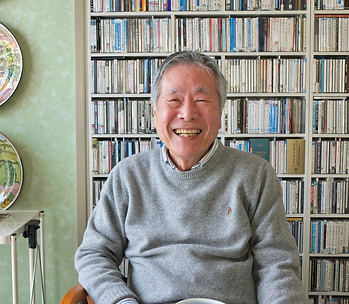
Japan Times
I am a frequent contributing writer for the Japan Times in the Life and Culture section. I write articles about Japanese art, photography, traditional arts and travel. See a selection of articles, published in the Japan Times, below. For all previously published articles and new contributions see: https://www.japantimes.co.jp/author/katherine-whatley/

Kiyoshi Koyama: A life lived with jazz
“I have lived a life alongside jazz,” says Kiyoshi Koyama, jazz critic, journalist and radio host. This is apparent on a recent visit to his home in Chiba Prefecture, where he and his wife live surrounded by walls of neatly organized records, CDs, books and other archives — a lifetime of research and study.
His many interviews with the greats of jazz — John Coltrane, Miles Davis, Ornette Coleman, Albert Ayler, Toshiko Akiyoshi — are preserved for posterity in cassette tapes and spiral-bound notebooks in his study and, though into his 80s, he has not stopped searching for new music, ideas or styles.
For full article see: https://www.japantimes.co.jp/culture/2018/03/29/music/kiyoshi-koyama-life-lived-jazz/#.WvJPoC-PDqQ

Living and breathing history, through noh
Noh performer Hisa Uzawa has spent her life devoted to an art form that — with its slow and steady movements, sparse staging and ancient chanting — may at first seem staid. In her hands, however, the 650-year-old tradition becomes relentlessly contemporary.
Uzawa was born into a noh family in 1949. Her father, Masashi, was a shite(lead actor) in the Kanze School and part of the Tessenkai Ensemble, and Uzawa grew up steeped in traditional music and arts.
For full article see: https://www.japantimes.co.jp/culture/2018/03/01/stage/living-breathing-history-noh/#.WvJPmi-PDqQ

Artist Asako Iwama explores the relationship between food and language
Food and the desire to eat has always been mysterious to Asako Iwama. When the artist and cook was a young child, she could not understand why she had to eat. Her earliest memories of food are of her grandmother’s cooking in a strange yet fascinating kitchen far away from home.
“My father is from Kamaishi in Iwate,” Iwama says. “My grandmother lived in a tiny one-story house with a kitchen. I grew up in a conventional postwar residential development, but my grandmother’s house was old and her kitchen looked like it was made of patchwork. She would prepare fish there, bought at 5 a.m., freshly caught, from the fish market just 300 or 400 meters away.”
For full article see: https://www.japantimes.co.jp/culture/2018/02/01/arts/artist-asako-iwama-explores-relationship-food-language/#.WvJPli-PDqQ

Two millennia of heritage along Wakayama’s Kumano Kodo trail
The Kii Peninsula is a land of ancient spiritual paths and holy mountains. Until the Meiji Era (1868-1912), the peninsula was the site of the Kii Province. Now, a part of Wakayama Prefecture, the area is famous for onsen(hot springs), fish and produce like mikan (mandarin oranges) and ume (plums), and is home to temperate rainforests, mountains and a beautiful coastline. The prefecture is known as a place of rich cultural heritage, in part because of its connection to the Kii Province and the Kumano Kodo trail, but also because of the many traditional arts that are practiced there, including aikido, which was founded by Morihei Ueshiba in Wakayama.
For full article see: https://www.japantimes.co.jp/life/2018/03/09/travel/two-millennia-heritage-along-wakayamas-kumano-kodo-trail/#.WvJPny-PDqQ

A cloven landscape, a cloven tree, a cloven self
On a recent trip to Tohoku, photographer Naoya Hatakeyama took a picture of a tree. It wasn’t a particularly remarkable tree, but it caught his attention all the same.
In Hatakeyama’s photo the tree stands in the middle distance, right in the center of the image. It is framed by a brilliant blue sky and clouds — perfect late summer weather. There is tall grass in the foreground, but the eye drifts back to the tree. A concrete bridge, a green-and-grey horizontal divide across the image, intersects the tree in the background and beyond that is a forest. But the photograph’s composition forces you back to the tree, standing alone and strong.
For full article see: https://www.japantimes.co.jp/culture/2018/01/04/arts/cloven-landscape-cloven-tree-cloven-self/#.WvJPkC-PDqQ